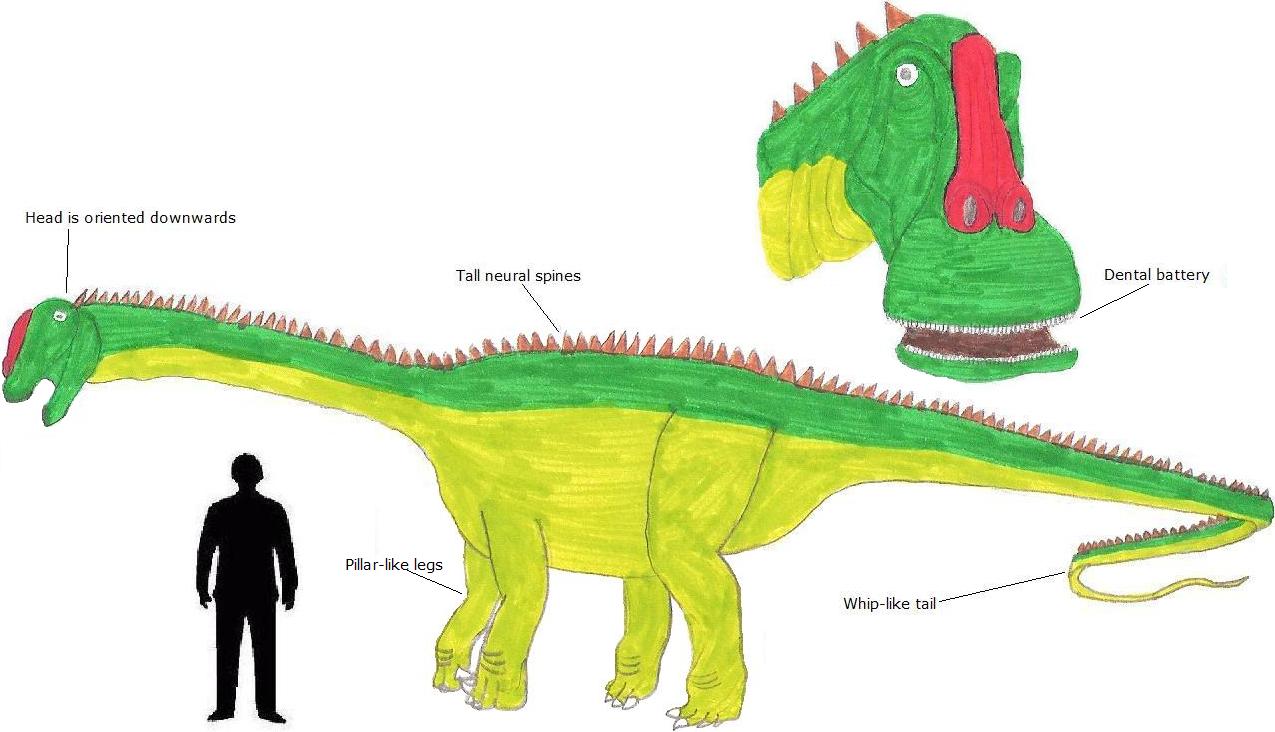ShopDreamUp AI ArtDreamUp
Deviation Actions
Suggested Deviants
Suggested Collections
You Might Like…
Featured in Groups
Description
Common name: Mowersaur
Scientific name: Megalomessor johndeerei
Time: Maastrichtian (65 million years ago)
Size: 11 meters long, 4 - 5 tons
Diet: Low-growing Plants
Distribution: Northern Africa
The last and largest non-titanosauriform sauropod of the Cretaceous world, the Mowersaur is a sad reminder to the longest animals ever to walk the earth, the Diplodocoids. The age of super-long dinosaurs like Diplodocus hallorum is bygone since the Jurassic, and with Ornithischians spreading over the world and competition from their titanosaurian cousins the group Diplodocoidea has become nearly extinct. But in Northern Africa they managed to win the battle against the titanosaurs thanks to a rather inconspicuous animal: Nigersaurus taqueti. This Rebbachisaurid had hundreds of pencil-shaped teeth in its mouth, all located at the front of the snout. Apart from the Ceratopsids and the duckbilled hadrosaurids it was the only dinosaur with a dental battery, and this more efficient feeding ability gave it the advantage over the titanosaurs.
The Maastrichtian Mowersaur hasn´t changed much from its ancestor Nigersaurus. It is a little bit larger but still small for a sauropod; even small when compared to some of its contemporaries! Because of its delicate and highly pneumatic skeleton this herbivore is much lighter than the massive hippo-like Heavy Honker of the same region. Like Nigersaurus the Mowersaur also has another odd feature: its inner ear is turned by 90°, so this dinosaur always has its head oriented downwards and thus is adapted for low-browsing. In the future its lineage will become much more successful because it is preadapted for eating grass.
Mowersaurs live in small groups in the deltas of Africa, feeding on both aquatic plants and low-growing terrestrial plants. Their only predators are the largest species of Crocodylomorphs, which are not afraid to tackle even fully-grown healthy adults. When threatened Mowersaurs turn away from the attacker and slash with their whip-like tails. Multiple fast strikes from these tails can even penetrate the armored snout of the Crocodylomorph, though to scare it away the diplodocoids have to slash its eyes. During mating time the bulls also use their whip-like tails against rival males; they also smack each other with their long necks like giraffes do. After laying their eggs Mowersaurs guard the nests, though they don´t take care of the hatched babies. When they have grown big enough the juveniles join one of the small groups for the rest of their life.
Scientific name: Megalomessor johndeerei
Time: Maastrichtian (65 million years ago)
Size: 11 meters long, 4 - 5 tons
Diet: Low-growing Plants
Distribution: Northern Africa
The last and largest non-titanosauriform sauropod of the Cretaceous world, the Mowersaur is a sad reminder to the longest animals ever to walk the earth, the Diplodocoids. The age of super-long dinosaurs like Diplodocus hallorum is bygone since the Jurassic, and with Ornithischians spreading over the world and competition from their titanosaurian cousins the group Diplodocoidea has become nearly extinct. But in Northern Africa they managed to win the battle against the titanosaurs thanks to a rather inconspicuous animal: Nigersaurus taqueti. This Rebbachisaurid had hundreds of pencil-shaped teeth in its mouth, all located at the front of the snout. Apart from the Ceratopsids and the duckbilled hadrosaurids it was the only dinosaur with a dental battery, and this more efficient feeding ability gave it the advantage over the titanosaurs.
The Maastrichtian Mowersaur hasn´t changed much from its ancestor Nigersaurus. It is a little bit larger but still small for a sauropod; even small when compared to some of its contemporaries! Because of its delicate and highly pneumatic skeleton this herbivore is much lighter than the massive hippo-like Heavy Honker of the same region. Like Nigersaurus the Mowersaur also has another odd feature: its inner ear is turned by 90°, so this dinosaur always has its head oriented downwards and thus is adapted for low-browsing. In the future its lineage will become much more successful because it is preadapted for eating grass.
Mowersaurs live in small groups in the deltas of Africa, feeding on both aquatic plants and low-growing terrestrial plants. Their only predators are the largest species of Crocodylomorphs, which are not afraid to tackle even fully-grown healthy adults. When threatened Mowersaurs turn away from the attacker and slash with their whip-like tails. Multiple fast strikes from these tails can even penetrate the armored snout of the Crocodylomorph, though to scare it away the diplodocoids have to slash its eyes. During mating time the bulls also use their whip-like tails against rival males; they also smack each other with their long necks like giraffes do. After laying their eggs Mowersaurs guard the nests, though they don´t take care of the hatched babies. When they have grown big enough the juveniles join one of the small groups for the rest of their life.
Image size
1275x732px 94.32 KB
© 2010 - 2024 Coelotitan
Comments4
Join the community to add your comment. Already a deviant? Log In
nigersaur




































